When thinking about home security, most homeowners focus on front doors, windows, and alarm systems — but often overlook one of the most vulnerable access points: the garage door. Whether attached to your home or detached, your garage provides not only storage but also a potential entryway for intruders.
In this guide, we’ll explore how to improve garage door security using practical upgrades, smart technology, and preventive maintenance. By the end, you’ll have a clear checklist of what to inspect, change, or enhance to better protect your home and family.
Why Garage Door Security Matters
Garages are often targeted because they’re less monitored and can contain high-value items like tools, bicycles, sporting equipment, and vehicles. If your garage is attached to your home, a security breach here can lead directly into your living space.
Common vulnerabilities include:
- Outdated or unsecured opener systems
- Weak or damaged door panels
- Easy access to emergency release cords
- Openers with unencrypted radio signals
Improving garage door security means addressing both physical and digital threats — and most solutions are easier than you might think.
1. Upgrade to a Smart Garage Door Opener
Older garage door openers, especially models made before 1993, lack modern security features and are more easily bypassed by intruders. Modern smart garage door openers not only improve convenience but offer serious security advantages.
Look for openers with:
- Rolling code technology (changes the access code with each use)
- Wi-Fi connectivity with smartphone control
- Security alerts for door activity
- Auto-close timers in case you forget to shut the door
Smart openers allow you to monitor and control your garage door remotely, helping prevent accidental vulnerabilities — like forgetting to close it when you leave.
2. Reinforce the Emergency Release Cord
The emergency release is designed to allow you to manually open the garage door during a power outage — but it’s also one of the most commonly exploited features by intruders. Thieves can use a coat hanger or similar tool to hook the release through a cracked door panel or weatherstripping.
How to secure it:
- Install a garage shield or cover to block access
- Zip-tie the cord in a way that allows manual use from inside but blocks external manipulation
- Ensure your door fits tightly in its frame with minimal gaps
These small changes can make a big difference in deterring break-ins.
3. Use Strong, Quality Door Materials
If your garage door is thin, cracked, or made from outdated materials, it could be a weak point in your home’s security system.
Recommended materials:
- Steel: Highly durable and impact-resistant
- Composite wood: Offers strength with curb appeal
- Insulated multi-layer doors: Improve both security and energy efficiency
Avoid older, single-layer doors made from aluminum or fiberglass, which can be easily dented or pried open.
4. Add a Manual Lock or Side Bolt
Even with a functioning opener, a manual lock provides an extra layer of protection — especially when you’re on vacation or leaving for extended periods.
Popular options:
- Slide bolts that engage with the track
- Padlock hasps for externally locking detached garages
- Interior T-handle locks that disengage the opener
When combined with smart opener controls, these manual systems give you peace of mind and physical reinforcement.
5. Install Motion-Activated Lighting
Bright lights not only improve visibility but act as a deterrent for would-be intruders. Motion-activated lighting alerts neighbors and homeowners that someone is near the garage and helps reduce blind spots.
Lighting placement tips:
- Above garage doors
- Alongside access doors or windows
- Inside the garage facing entry points
Opt for LED systems with wide detection angles and adjustable sensitivity for best coverage.
6. Secure Side and Interior Garage Doors
Many break-ins happen through side or interior garage doors that are left unlocked or poorly reinforced. These doors should be treated just like your front or back doors.
Improve door security by:
- Installing solid-core or metal doors
- Using deadbolt locks
- Adding door sensors connected to your security system
- Ensuring door frames are reinforced and have no rot or warping
Even better, install smart locks that you can control remotely.
7. Cover Garage Door Windows
Garage windows add visual appeal but also allow prying eyes to see what’s inside — including whether anyone’s home or if valuables are stored inside.
Options to protect privacy:
- Frosted or tinted film to obscure the view
- Blinds or shades on interior windows
- Windowless door models for complete concealment
If your garage doubles as a workspace or storage area, window coverage is an easy win for both security and energy savings.
8. Integrate Your Garage Into Your Home Security System
Your home alarm system should include garage entry points — both the overhead door and any pedestrian doors.
Recommended components:
- Door and motion sensors inside the garage
- Surveillance cameras at all garage access points
- Smart notifications when doors are opened or remain open too long
Many smart garage openers integrate with platforms like Ring, ADT, or Google Home, offering full control from one dashboard.
9. Keep Your Opener Remote Secure
Leaving your remote in your car — especially if parked outside — is a major security risk. A thief can break into your car and use the remote to access your home.
Best practices:
- Use keychain remotes you can carry with you
- Clear your remote from any old cars or loaned vehicles
- Disable remote access when you’re away for long periods
If your vehicle has built-in HomeLink controls, be sure to password protect the vehicle as well.
Real-World Scenario: Smart Upgrade Prevents Break-In
A homeowner in Phoenix upgraded their old garage door opener with a smart model featuring rolling codes and mobile notifications. Just one month later, they received a late-night alert that their garage door had been activated — even though they weren’t home.
Because the smart opener blocked code duplication and logged activity, the door never opened. The homeowner was able to review camera footage and report the attempted break-in, avoiding theft and reinforcing the home’s perimeter with new lighting and reinforced side doors.
Final Thoughts
Your garage is more than just a storage space — it’s a key access point to your home. By securing your garage door with modern technology, smart habits, and physical reinforcements, you reduce your exposure to break-ins and help ensure the safety of your home and loved ones.
At DuraServ, we help homeowners upgrade and secure their garage doors with the latest in residential technology and hardware. Whether you need a full door replacement, opener upgrade, or expert inspection, our team is ready to help you feel safe and confident at home.



